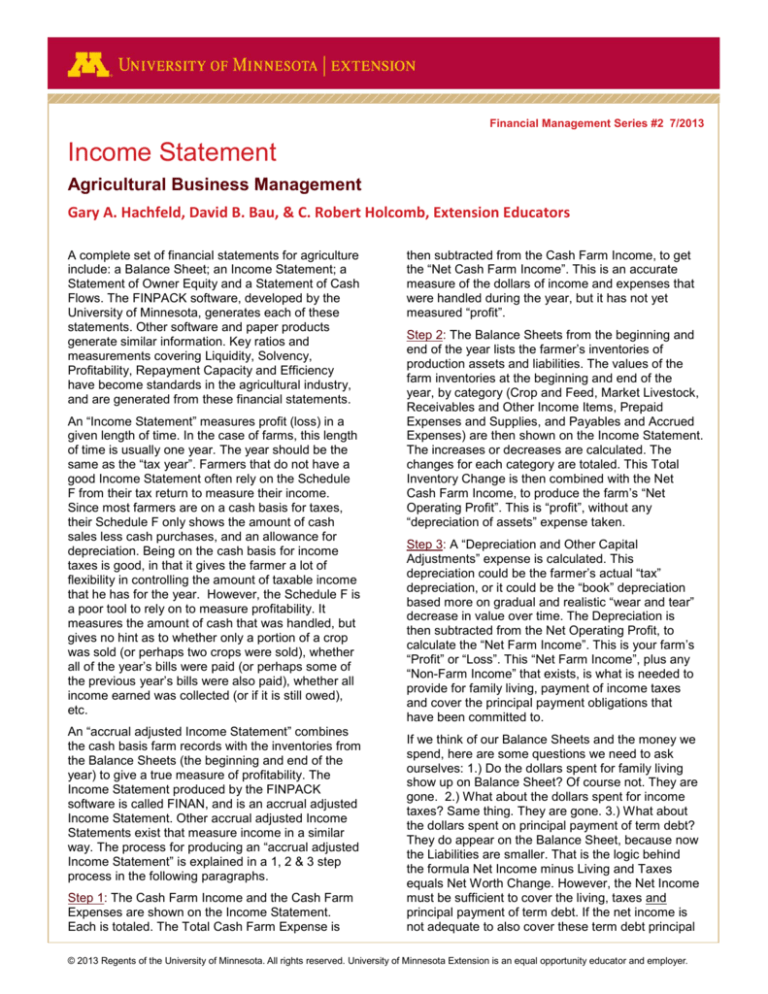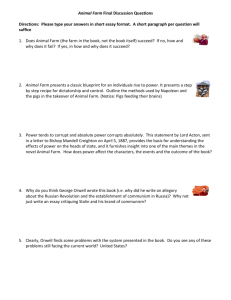
Financial Management Series #2 7/2013
Income Statement
Agricultural Business Management
Gary A. Hachfeld, David B. Bau, & C. Robert Holcomb, Extension Educators
A complete set of financial statements for agriculture
include: a Balance Sheet; an Income Statement; a
Statement of Owner Equity and a Statement of Cash
Flows. The FINPACK software, developed by the
University of Minnesota, generates each of these
statements. Other software and paper products
generate similar information. Key ratios and
measurements covering Liquidity, Solvency,
Profitability, Repayment Capacity and Efficiency
have become standards in the agricultural industry,
and are generated from these financial statements.
An “Income Statement” measures profit (loss) in a
given length of time. In the case of farms, this length
of time is usually one year. The year should be the
same as the “tax year”. Farmers that do not have a
good Income Statement often rely on the Schedule
F from their tax return to measure their income.
Since most farmers are on a cash basis for taxes,
their Schedule F only shows the amount of cash
sales less cash purchases, and an allowance for
depreciation. Being on the cash basis for income
taxes is good, in that it gives the farmer a lot of
flexibility in controlling the amount of taxable income
that he has for the year. However, the Schedule F is
a poor tool to rely on to measure profitability. It
measures the amount of cash that was handled, but
gives no hint as to whether only a portion of a crop
was sold (or perhaps two crops were sold), whether
all of the year’s bills were paid (or perhaps some of
the previous year’s bills were also paid), whether all
income earned was collected (or if it is still owed),
etc.
An “accrual adjusted Income Statement” combines
the cash basis farm records with the inventories from
the Balance Sheets (the beginning and end of the
year) to give a true measure of profitability. The
Income Statement produced by the FINPACK
software is called FINAN, and is an accrual adjusted
Income Statement. Other accrual adjusted Income
Statements exist that measure income in a similar
way. The process for producing an “accrual adjusted
Income Statement” is explained in a 1, 2 & 3 step
process in the following paragraphs.
Step 1: The Cash Farm Income and the Cash Farm
Expenses are shown on the Income Statement.
Each is totaled. The Total Cash Farm Expense is
then subtracted from the Cash Farm Income, to get
the “Net Cash Farm Income”. This is an accurate
measure of the dollars of income and expenses that
were handled during the year, but it has not yet
measured “profit”.
Step 2: The Balance Sheets from the beginning and
end of the year lists the farmer’s inventories of
production assets and liabilities. The values of the
farm inventories at the beginning and end of the
year, by category (Crop and Feed, Market Livestock,
Receivables and Other Income Items, Prepaid
Expenses and Supplies, and Payables and Accrued
Expenses) are then shown on the Income Statement.
The increases or decreases are calculated. The
changes for each category are totaled. This Total
Inventory Change is then combined with the Net
Cash Farm Income, to produce the farm’s “Net
Operating Profit”. This is “profit”, without any
“depreciation of assets” expense taken.
Step 3: A “Depreciation and Other Capital
Adjustments” expense is calculated. This
depreciation could be the farmer’s actual “tax”
depreciation, or it could be the “book” depreciation
based more on gradual and realistic “wear and tear”
decrease in value over time. The Depreciation is
then subtracted from the Net Operating Profit, to
calculate the “Net Farm Income”. This is your farm’s
“Profit” or “Loss”. This “Net Farm Income”, plus any
“Non-Farm Income” that exists, is what is needed to
provide for family living, payment of income taxes
and cover the principal payment obligations that
have been committed to.
If we think of our Balance Sheets and the money we
spend, here are some questions we need to ask
ourselves: 1.) Do the dollars spent for family living
show up on Balance Sheet? Of course not. They are
gone. 2.) What about the dollars spent for income
taxes? Same thing. They are gone. 3.) What about
the dollars spent on principal payment of term debt?
They do appear on the Balance Sheet, because now
the Liabilities are smaller. That is the logic behind
the formula Net Income minus Living and Taxes
equals Net Worth Change. However, the Net Income
must be sufficient to cover the living, taxes and
principal payment of term debt. If the net income is
not adequate to also cover these term debt principal
© 2013 Regents of the University of Minnesota. All rights reserved. University of Minnesota Extension is an equal opportunity educator and employer.
payments, either they will: 1.) not get paid, 2.) will
get paid, but will be borrowed elsewhere (perhaps
on the operating loan), or 3.) will be paid from the
liquidation of assets.
The existence of adequate Net Income is absolutely
key to the survival of a farm business. How do you
measure whether it exists? The “accrual adjusted
Income Statement”. Without a good accrual adjusted
Income Statement, how would you know if there was
a profit? That is a good question.
Liquidity and Solvency ratios and measurements are
calculated from your Balance Sheet. When we have
a good Income Statement, ratios and measurements
on Profitability, Repayment Capacity and Efficiency
can be calculated.
Some of these measurements come only from the
Income Statement, while others require both a good
Balance Sheet and a good Income Statement.
See Financial Management Series #5-Ratios and
Measurements.
It is important for the farmer to have good financial
statements and analysis, and to understand them.
After all, it is their financial life.
Caution: This publication is offered as educational
information. It does not offer legal advice. If you
have questions on this information, contact an
attorney.
© 2013 Regents of the University of Minnesota. All rights reserved. University of Minnesota Extension is an equal opportunity educator and employer.






